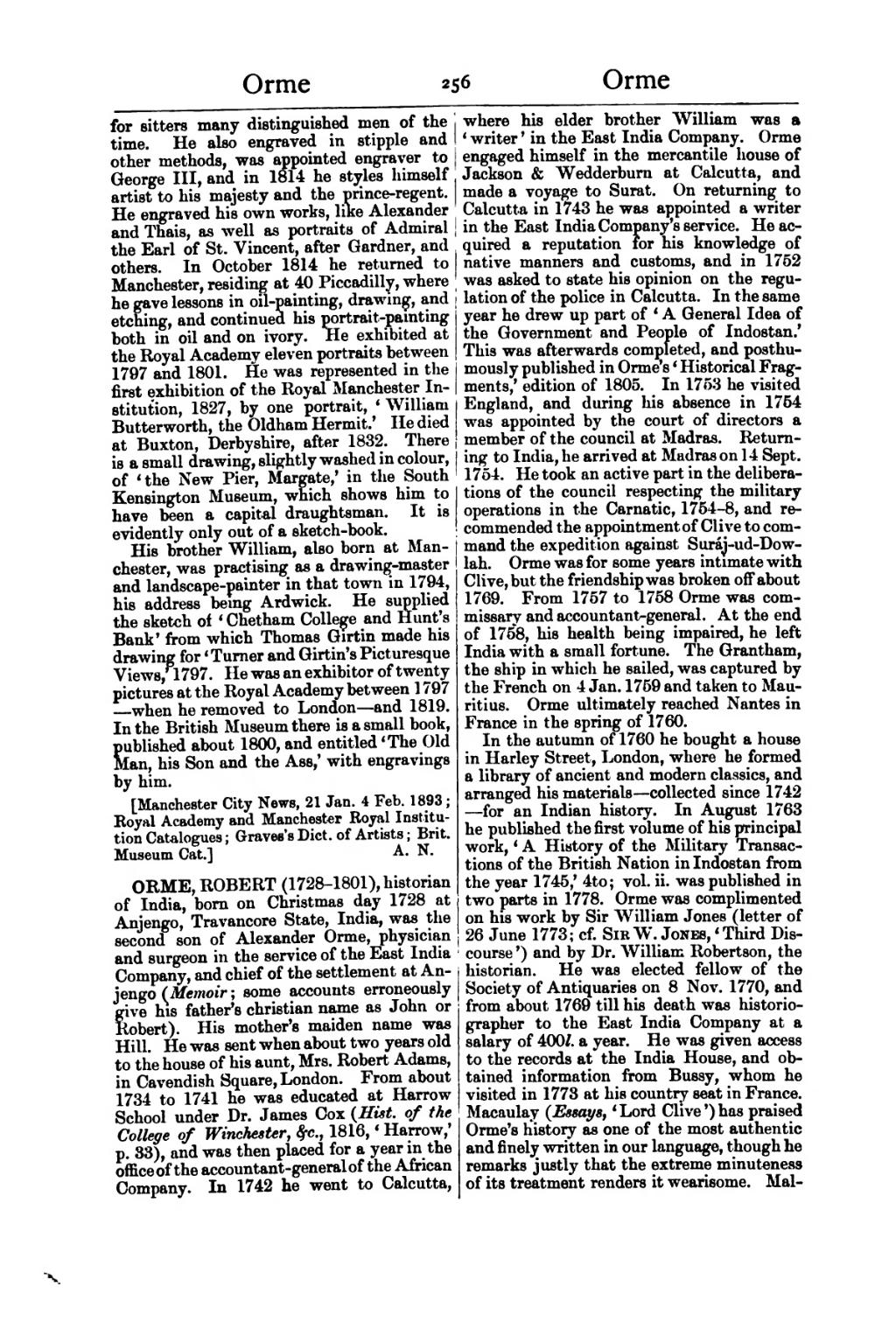for sitters many distinguished men of the time. He also engraved in stipple and other methods, was appointed engraver to George III, and in 1814 he styles himself artist to his majesty and the prince-regent. He engraved his own works, like Alexander and Thais, as well as portraits of Admiral the Earl of St. Vincent, after Gardner, and others. In October 1814 he returned to Manchester, residing at 40 Piccadilly, where he gave lessons in oil-painting, drawing, and etching, and continued his portrait-painting both in oil and on ivory. He exhibited at the Royal Academy eleven portraits between 1797 and 1801. He was represented in the first exhibition of the Royal Manchester Institution, 1827, by one portrait, ‘William Butterworth, the Oldham Hermit.’ He died at Buxton, Derbyshire, after 1832. There is a small drawing, slightly washed in colour, of ‘the New Pier, Margate,’ in the South Kensington Museum, which shows him to have been a capital draughtsman. It is evidently only out of a sketch-book. His brother William, also born at Manchester, was practising as a drawing-master and landscape-painter in that town in 1794, his address being Ardwick. He supplied the sketch of ‘Chetham College and Hunt's Bank’ from which Thomas Girtin made his drawing for ‘Turner and Girtin's Picturesque Views,’ 1797. He was an exhibitor of twenty pictures at the Royal Academy between 1797—when he removed to London—and 1819. In the British Museum there is a small book, published about 1800, and entitled ‘The Old Man, his Son and the Ass,’ with engravings by him.
[Manchester City News, 21 Jan. 4 Feb. 1893; Royal Academy and Manchester Royal Institution Catalogues; Graves's Dict. of Artists; Brit. Museum Cat.]
ORME, ROBERT (1728–1801), historian of India, born on Christmas day 1728 at Anjengo, Travancore State, India, was the second son of Alexander Orme, physician and surgeon in the service of the East India Company, and chief of the settlement at Anjengo (Memoir; some accounts erroneously give his father's christian name as John or Robert). His mother's maiden name was Hill. He was sent when about two years old to the house of his aunt, Mrs. Robert Adams, in Cavendish Square, London. From about 1734 to 1741 he was educated at Harrow School under Dr. James Cox (Hist. of the College of Winchester, &c., 1816, ‘Harrow,’ p. 33), and was then placed for a year in the office of the accountant-general of the African Company. In 1742 he went to Calcutta, where his elder brother William was a ‘writer’ in the East India Company. Orme engaged himself in the mercantile house of Jackson & Wedderburn at Calcutta, and made a voyage to Surat. On returning to Calcutta in 1743 he was appointed a writer in the East India Company's service. He acquired a reputation for his knowledge of native manners and customs, and in 1752 was asked to state his opinion on the regulation of the police in Calcutta. In the same year he drew up part of ‘A General Idea of the Government and People of Indostan.’ This was afterwards completed, and posthumously published in Orme's ‘Historical Fragments,’ edition of 1805. In 1753 he visited England, and during his absence in 1754 was appointed by the court of directors a member of the council at Madras. Returning to India, he arrived at Madras on 14 Sept. 1754. He took an active part in the deliberations of the council respecting the military operations in the Carnatic, 1754–8, and recommended the appointment of Clive to command the expedition against Suráj-ud-Dowlah. Orme was for some years intimate with Clive, but the friendship was broken off about 1769. From 1757 to 1758 Orme was commissary and accountant-general. At the end of 1758, his health being impaired, he left India with a small fortune. The Grantham, the ship in which he sailed, was captured by the French on 4 Jan. 1759 and taken to Mauritius. Orme ultimately reached Nantes in France in the spring of 1760.
In the autumn of 1760 he bought a house in Harley Street, London, where he formed a library of ancient and modern classics, and arranged his materials—collected since 1742—for an Indian history. In August 1763 he published the first volume of his principal work, ‘A History of the Military Transactions of the British Nation in Indostan from the year 1745,’ 4to; vol. ii. was published in two parts in 1778. Orme was complimented on his work by Sir William Jones (letter of 26 June 1773; cf. Sir W. Jones, ‘Third Discourse’) and by Dr. William Robertson, the historian. He was elected fellow of the Society of Antiquaries on 8 Nov. 1770, and from about 1769 till his death was historiographer to the East India Company at a salary of 400l. a year. He was given access to the records at the India House, and obtained information from Bussy, whom he visited in 1773 at his country seat in France. Macaulay (Essays, ‘Lord Clive’) has praised Orme's history as one of the most authentic and finely written in our language, though he remarks justly that the extreme minuteness of its treatment renders it wearisome. Mal-
